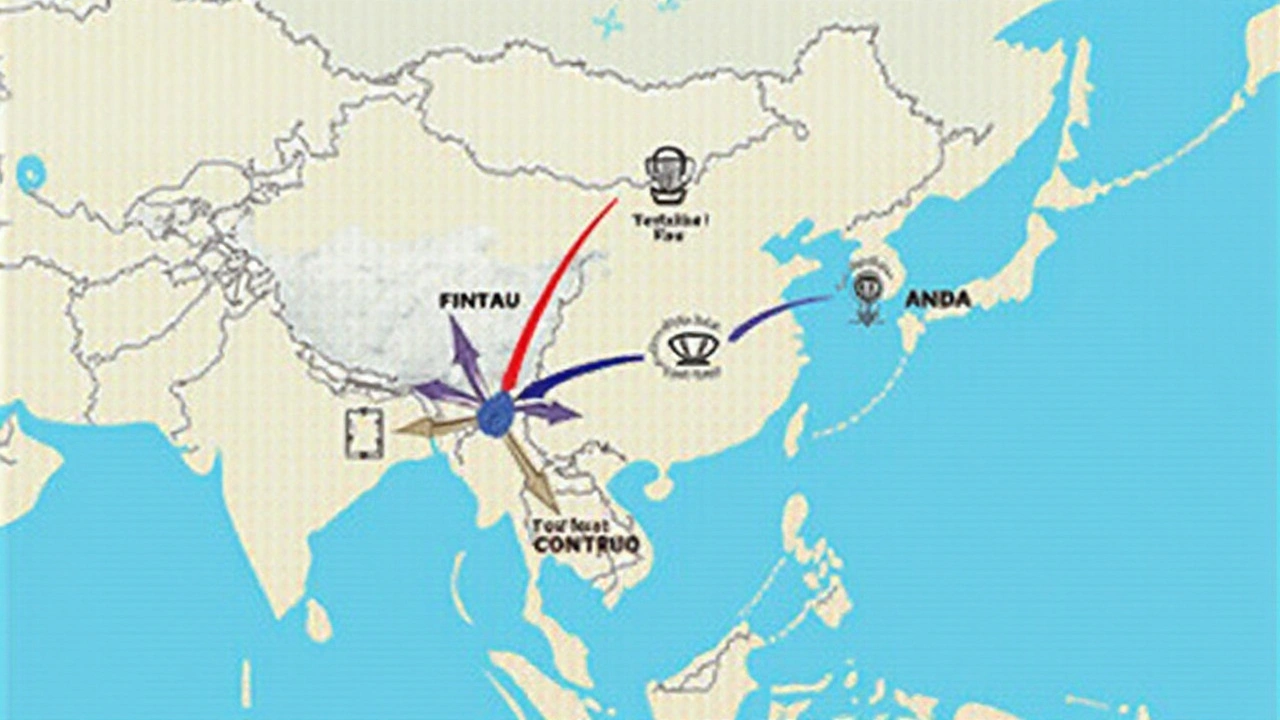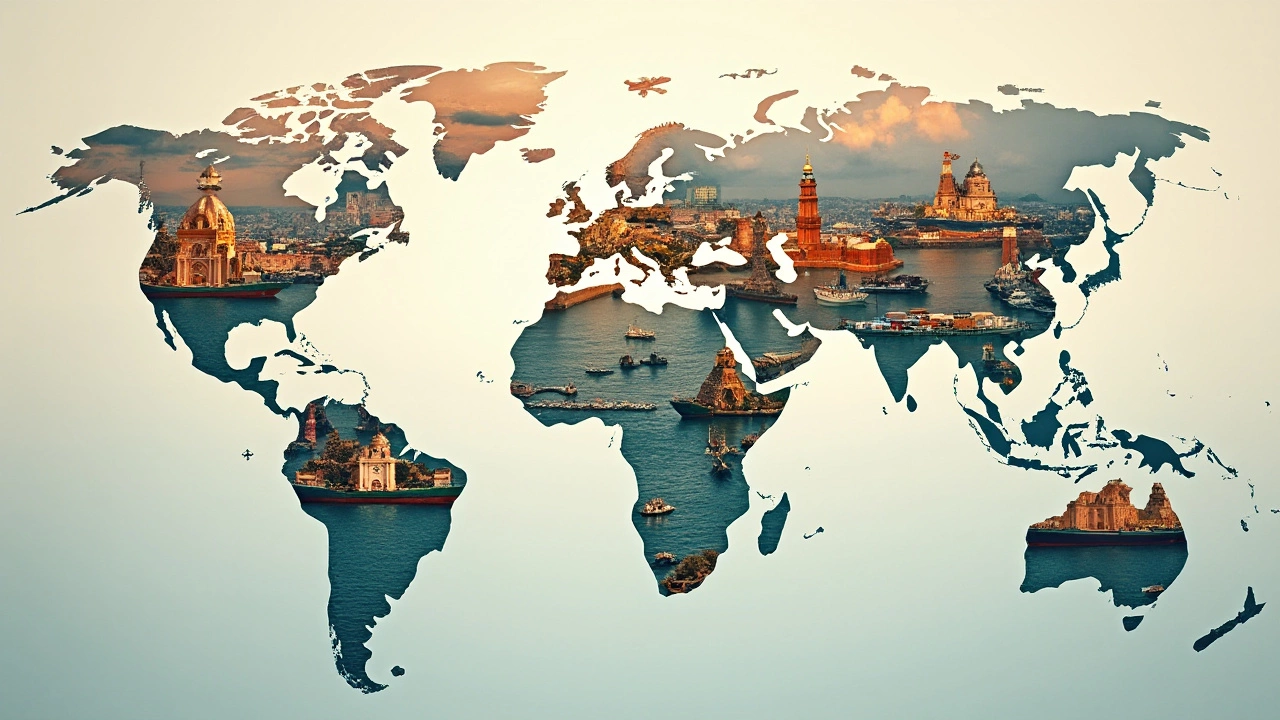
In the world of global trade, nations are like neighbors swapping goods over the fence. India, with its booming economy and strategic geography, has a few notable swapping partners. Anyone curious about the intricate dance of exports and imports will find India’s trading relationships quite enlightening.
Today, India's top trading partners are a reflection of its diverse economic network. From technology exchanges with countries far west to resource-driven imports from next-door neighbors, each partner plays a unique role in shaping the contours of India's economy.
This exploration helps budding traders and economists understand the trajectories and trends influencing India's trade scene. Diverse narratives from the past to the present weave together to form India's complex tapestry of commercial relations, vital for anyone seeking a meaningful grasp on global trade dynamics.
- Historical Trade Alliances
- Key Trading Nations Today
- Economic Impact and Growth
- Tips for Aspiring Traders
Historical Trade Alliances
Delving into the history of India's trade alliances takes us on a journey through time, one that starts long before the contemporary economic landscape we are familiar with today. Trading routes such as the Silk Road and maritime links that spanned across oceans have played pivotal roles in shaping India's ancient interactions with other civilizations. Notably, India's robust trade with ancient civilizations like Mesopotamia and Egypt has been well-documented, including the exchange of spices, textiles, and precious stones. These trading activities laid the foundation for India's rich cultural and economic tapestry, influencing everything from culinary arts to architectural styles that we see today.
During the medieval period, the Indian subcontinent saw prosperity through its connections with far-off regions, notably during the reigns of powerful dynasties like the Mauryas and the Guptas. These periods were marked by significant trade in silk, cotton, and various indigenous goods, elevating India's stature in the global market. Historical texts and records reveal that the ports of Gujarat and the Malabar Coast were bustling hubs of maritime commerce, drawing merchants and explorers from across the globe. These seafaring voyages fostered cultural exchanges, influencing India's societal fabric in unimaginable ways.
The advent of the European colonial powers in India marked a profound shift in these historical trade patterns. The British East India Company, for instance, manipulated these trade networks to secure economic dominance, significantly influencing India's economic structure into the colonial period. This era saw the establishment of monopolistic trading practices, with vast quantities of cotton and tea making their way to European shores, shifting the balance of economic power significantly. A quote from the esteemed historian, Dr. Romesh Chunder Dutt, encapsulates this period succinctly:
"India was a prized possession not merely because of the wealth concealed within its territories, but also because control over its trade routes meant domination of a colossal share of the world’s trade."
Post-independence, India witnessed a tectonic shift as it sought to redefine its trade policies, favoring a more balanced approach to economic alliances. The evolution of its trading partnerships post-1947 involved significantly diversified trade relations with an emphasis on strengthening ties within the Asian continent and the broader third world. With the economic liberalization in the 1990s, India's trade canvas expanded, leading to an economic renaissance that invited investments and trade agreements from formidable economies worldwide. This liberalization period laid the groundwork for modern trade courses in India that educate budding economists and traders about navigating this dynamic space.
Understanding the intricacies of India's historical trade alliances remains crucial for anyone delving into global economies. Those invested in learning about India's economic past gain insights that are not just academic, but deeply woven into the narrative of world trade history. Lessons drawn from these past alliances offer a tempered perspective that can unfurl opportunities for contemporary entrepreneurs and policymakers alike, paving the way for resilient economic strategies tailored to our current global trading landscape.

Key Trading Nations Today
When we talk about the major trading players in India's economy, a few countries consistently come to the forefront. China, for instance, stands out prominently as a major partner, its influence extending across numerous sectors. From electronics to machinery and textiles, China finds itself deeply embedded in India's import fabric. On the other hand, India's exports to China include iron ore, cotton, and more recently, a significant amount of pharmaceutical products. This mutual relationship underscores how both nations, despite historical and political differences, have found economic synergy as a compelling reason to maintain strong economic ties.
Another significant partner is the United States, which continues to be a determinant in India's economic policies and strategies. The Indo-American trade relation is marked by technology flows, software exports, and an increasing trend in service trade. The IT sector, in particular, has been a game-changer with firms in both countries collaborating on innovative technologies and services. “Our economic relations are one of the biggest drivers of our bilateral engagement,” remarked a prominent figure in Indo-US relations, underscoring the mutually beneficial nature of their trade.
Looking towards Europe, Germany and the United Kingdom represent important pillars in India’s trade infrastructure. With Germany, machine tools and automobile parts are significant areas of commerce. Whereas with the United Kingdom, financial services, pharmaceuticals, and textiles play a crucial role. This European involvement complements India's existing strength in services and manufacturing, fueling economic growth on both sides of the equation.
Among its neighbors, Bangladesh and Nepal are quite integral as well. Not only do these nations share geographical proximity but they are also cultural brethren. Thus, trade between these nations thrives on familiarity and historical ties. Textiles, agricultural products, and manufactured goods often find themselves crossing borders daily, nurturing a vibrant economic ecosystem among South Asian countries.
To give a clearer picture of India's vibrant trade relations, here is a concise breakdown of trade figures:
| Country | Exports (in Billion USD) | Imports (in Billion USD) |
|---|---|---|
| China | 16.34 | 75.31 |
| United States | 53.23 | 35.55 |
| Germany | 8.44 | 12.72 |

Economic Impact and Growth
India's meteoric rise as an economic powerhouse has profound implications, not just for its citizens but the global market at large. At the core of this transformation lies its intricate web of international trade engagements. From the bustling ports of Mumbai to the tech hubs in Bengaluru, India has leveraged these international connections to spark an era of unprecedented growth. This growth trajectory is underpinned by strategic partnerships with some of the world's largest economies. China's position as a significant player comes to mind, with the trade relationship defined by an exchange of electronics, machinery, and pharmaceuticals. Importantly, this flow of goods fuels India's innovation, allows access to technologies, and supports consumer needs.India's economy is a testament to lucrative ties with nations committed to mutual growth.
The impact of trade courses in India is also transforming the foundational layers of India's economic strategy. With a growing emphasis on education and skill development in commerce, an increasing number of professionals are empowering themselves with knowledge of global trade dynamics. These courses help decipher market trends, equip traders to tackle challenges, and open avenues for new synergies. It's no wonder that India's participation in the global market is increasingly characterized by asserting more negotiating power. Economists believe that India's demographic dividend offers significant economic advantages. They argue that as the global population ages, India’s youthful population equips it with a robust labor force conducive to economic dynamism.
In recent years, the government has introduced reforms to ease trade flows and attract foreign direct investment, further enhancing the economic growth. It is notable that the 'Make in India' initiative is particularly influential, encouraging domestic manufacturing while reducing import reliance. Notably, the World Bank has lauded India's improving ranking in the ease of doing business index, emphasizing the country's commitment to business-friendly reforms. This approach fortifies India's ambitions, ultimately paving the way for healthier trade relations.
Understanding the trade balance paints an even richer picture. While India thrives in sectors such as software, chemicals, and textiles, these outputs sustain an advantageous export surplus. This growth is quietly powering infrastructure projects across the nation. Not only does it bolster job creation and enhance skills, but it also advances socio-economic indicators. The stories emerging from this economic narrative assure that India's steps on the global stage pose opportunities for a significant reshaping of regional and global economic landscapes.

Tips for Aspiring Traders
Embarking on a journey into the vibrant world of trade can be both exhilarating and daunting. As aspiring traders look towards tapping into the dynamic landscape of India's economy, understanding the key principles and nuances can make all the difference. The trade market is an ocean, teeming with opportunities and unseen currents. Navigating this requires not just knowledge of facts and figures, but also an intuitive feel for market moves, cultural contexts, and economic shifts. One essential tip is to always stay updated with current events, both locally and globally. Reading widely and regularly, especially trusted financial news sources, will keep you informed about which trading partners are growing in importance.
A critical aspect of trading is understanding consumer markets and demands. For instance, India, with its growing middle class and tech-savvy youth, has a surging appetite for electronic goods. Recognizing these trends can provide insights into where to focus trading efforts. Additionally, learning from the experiences of seasoned traders can offer valuable insights. Consider joining networks and forums where you can exchange ideas, ask questions, and gain from others' experiences. Mentorship, whether formal or informal, can significantly influence a trader's path.
Developing a robust risk management strategy is another cornerstone for success. The trade industry is subject to unpredictable factors such as currency fluctuations, geopolitical issues, and domestic policies. Being prepared involves setting clear goals, knowing your limits, and continuously reviewing your strategies. Moreover, technology, the great equalizer, provides unprecedented tools for monitoring markets, conducting transactions, and analyzing trends. Embrace tech solutions that enhance your efficiency and decision-making prowess.
Consider this reflective observation from Warren Buffett, an iconic figure in trading circles:
"Risk comes from not knowing what you're doing."This serves as a reminder of the importance of preparation and research in mitigating risks. Lastly, always build relationships with key stakeholders—manufacturers, suppliers, customers, and even competitors. Building trust and understanding across these relationships can often lead to more opportunities than you might anticipate, opening new doors and creating lasting partnerships.
To sum up these tips, I'll leave you with a basic framework: stay informed, integrate technology smartly, manage risks carefully, learn from others, and nurture your network. Together, these will guide you towards becoming an adept player in the field of trade.
